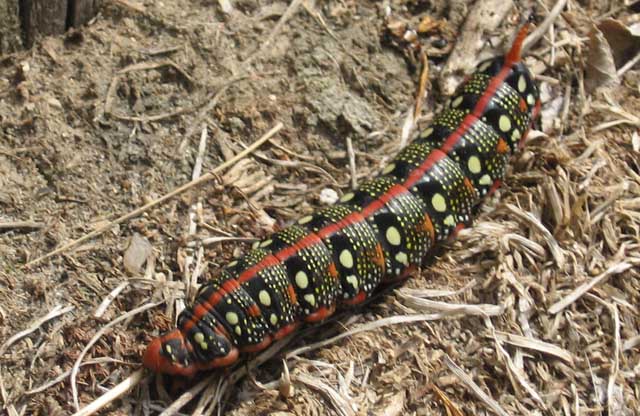Hill County, Montana
Sphingidae Larvae
Hyles euphorbiae, Havre, Hill County, Montana,
August 19, 2009, courtesy of Ginger Adams.
|
|
Inspired by and dedicated to Ginger Adams, August 19, 2009 Updated as per James P. Tuttle's The Hawk Moths of North America, August, 2009 |

Hyles euphorbiae, Havre, Hill County, Montana,
August 19, 2009, courtesy of Ginger Adams.
Ginger writes, "I live in Havre, Montana, and I ran accross your website while I was searching for info on the bedstraw hawk-moth.
I wanted to let you know I (rather my cat) has found two Hyles euphorbiae, (not Hyles gallii as originally thought) larvae in my yard. I will send you pictures if you would like."
For care of "found larvae/caterpillars" visit Manduca sexta larva, central Texas, August 21, 2008, Trina Woodall.
Only ten Sphingidae species are listed for Montana on the U.S.G.S. website. Not all of the species are reported or anticipated in Hill County (One (Hemaris diffinis) is reported on U.S.G.S. as of August, 2009). It is hoped that this checklist, with the thumbnails and notes, will help you quickly identify the larvae you are likely to encounter. A "WO" after the species name indicates that I have no confirmed reports of this species in your county, but I (William Oehlke) expect that this moth with its larvae are present or might be present.
A "USGS" indicates the moth is reported in Lepidoptera of North America, #1. Distribution of Silkmoths (Saturniidae) and Hawkmoths (Sphingidae) of Eastern North America, an excellent little booklet available through Paul Opler.
Please help me develop this list with improved, documented accuracy by sending sightings (species, date, location), preferably with an electronic image, via email to Bill Oehlke.
Sphinginae subfamily
Smerinthini Tribe:
Macroglossinae subfamilyDilophonotini tribe:
Macroglossini tribe:
|
Enjoy some of nature's wonderments, giant silk moth cocoons. These cocoons are for sale winter and fall. Beautiful Saturniidae moths will emerge the following spring and summer. Read Actias luna rearing article. Additional online help available.
Eggs of many North American species are offered during the spring and summer. Occasionally summer Actias luna and summer Antheraea polyphemus cocoons are available. Shipping to US destinations is done from with in the US.
Use your browser "Back" button to return to the previous page.
This page is brought to you by Bill Oehlke and the WLSS. Pages are on space rented from Bizland. If you would like to become a "Patron of the Sphingidae Site", contact Bill.
Please send sightings/images to Bill. I will do my best to respond to requests for identification help.
 Show appreciation for this site by clicking on flashing butterfly to the left. The link will take you to a page with links to many insect sites. |
I very much appreciate all the many images that have been sent to me, or of which I have been granted permission to copy and post from other websites. All images on this site remain the property of respective photographers.
If you would like to contribute to the maintenace of this website by sending a contribution to
Bill Oehlke
Box 476
155 Peardon Road
Montague, Prince Edward Island, C0A1R0
Canada
your donation would be much appreciated and would be used for
1) paying for webspace rental;
2) paying for computer maintenance and software upgrades;
3) purchases of additional text reference material (journals and books) in anticipation of expanding the site to a worldwide Sphingidae site;
4) helping to pay my daughter's tuition; with anything left over going to humanitarian aid.
If you are mailing a check from USA, please use $0.85 postage. Donations can also be made through Paypal via the button below.